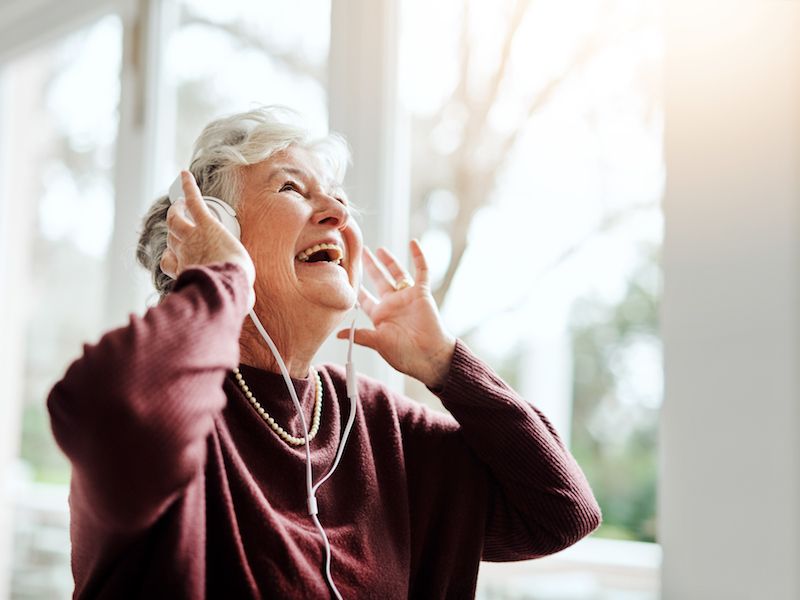
Individuals who work in loud surroundings such as construction sites or at heavy metal concerts are not the only ones impacted by noise related loss of hearing. It doesn’t even need to be work-related, leisure-related noise exposure can be dangerous, also. The most common type? Music, gaming, streaming video or anything that you would listen to through headphones or earbuds.
You may be alarmed to find out that a mobile device can go that loud. The ordinary pain threshold for human hearing is roughly 150 db which is in the range of these devices. This is the volume where noise starts to literally hurt your ears. So what’s the solution for protecting your hearing against volume related damage.
It’s important here to consider the volume. Listen with the volume at or below 60% for no more than 60 minutes each session (how long you listen for also matters), this is called the 60/60 rule.
Your Hearing Aids Can be Set up For Music
If you wear hearing aids, you’re likely streaming your device right to your hearing aids, so be certain the volume is not too loud or that you’re not trying to drown out other noises with your music. In addition, consult us about how to best listen to music. If you’re a musician or someone who loves music you may have noticed that most hearing aids are programmed to enhance the quality of voices…not necessarily music. We might be able to make adjustments to reduce feedback and noise while maximizing some frequency ranges to enhance the quality of sound when listening to music.
How to Pick The Best Headphones
If you don’t have hearing aids, there are many options for shopping for headphones. There are various things to think about, even though it’s largely a matter of personal preference.
Headphones That go Over The Ears
Over the ear headphones are becoming popular again but you most likely won’t see the old foam covered speakers that used to come with a walkman. Often shockingly pricey, they provide a large variety of color choices and celebrity endorsements, and of course, superior sound quality. And unlike those little foam pads, these cover the whole ear, limiting outside noises.
Conventional perception is that these are less dangerous than in-ear headphones because the source of the sound is further from your eardrum. But because the speakers are bigger they are commonly capable of much higher sound level. Additionally, noise-canceling might help you ignore the crying baby on your flight, but in other circumstances, it can block sounds you should hear (like a honking car). With that being said, because they block out outside noise, you can typically lower the volume of what you’re listening to so it’s not loud enough to cause damage to your ears.
Earbuds
The standard earbuds that are included with devices such as iPhones are much maligned for their inferior quality of sound, though lots of people still use them because hey, they came with the phone. Plus, with newer versions that lack a headphone jack, staying with Apple’s earbuds can just be easier.
Earbuds also don’t block out sound so the drawback is, you tend to turn up the sound level. Once again,, though it’s commonly said that earbuds are problematic because you put them in your ear so their speakers are really close to your eardrum, actually volume is really the biggest issue.
Noise Canceling Earbuds
More comfortable than standard earbuds, models that have a round rubber tip are the choice of many because they help stop outside noise. A seal that stops outside noise from entering is formed by the rubber tip which conforms to the shape of the ear. Not to sound like a broken record, but these have the same drawbacks as the other two (it’s all about the volume), as well as carrying the same caution as over-the-ear headphones (they can block out warning sounds). And if you have hearing aids, obviously these won’t work for you.
A number of pairs may have to be tested before you find headphones that are what you are looking for. Depending on what you regularly use them for say talking on the phone, as opposed to listening to music, you’ll have unique acoustic requirements. The essential thing is to find headphones that make it comfortable for you to listen at a safe and secure volume.
How to Make Sure Your Hearing is Safeguarded
Is it Safe, How Can I be certain? If you have a smartphone, you can get an app for that, you can download the National Institute for Occupational Safety and Health’s free Sound Level Meter app. There are different apps out there, but research has found that the reliability of these other apps is spotty (in addition, for whatever reason, Android-based apps have been shown less precise). That motivated NIOSH to create their own app. The app allows you to measure outside sounds, but it’s also possible to measure the sound coming from your device’s speakers, in other words, the true volume of what’s being sent to your ears. It’s a little bit of work, but taking these types of protective steps can help safeguard your hearing.
